
The Yashica Mat 124 is a twin-lens reflex camera designed for medium format photography, supporting both 120 and 220 film. Known for its durability and ease of use, it has become a favorite among photographers transitioning from 35mm to medium format. This guide provides detailed insights into its features, operation, and maintenance, helping users master the camera’s capabilities and troubleshoot common issues effectively.
Overview of the Yashica Mat 124 Camera
The Yashica Mat 124 is a twin-lens reflex medium format camera that supports both 120 and 220 film, offering 12 and 24 exposures respectively. Designed for ease of use, it features a durable build and intuitive controls, making it a popular choice for photographers transitioning to medium format. The camera’s manual provides detailed guidance on functionality, configuration, and troubleshooting, ensuring optimal performance. Its twin-lens design allows for precise focusing and composition, while the compatibility with different film types offers versatility. Whether for professional or hobbyist use, the Yashica Mat 124 remains a reliable tool for capturing high-quality images with timeless appeal.
Importance of the Manual for Proper Usage
The manual is essential for understanding the Yashica Mat 124’s functionality, ensuring optimal performance, and preventing damage. It provides detailed instructions on camera operation, film loading, and maintenance, as well as troubleshooting common issues. With sections on aperture, shutter settings, and flash synchronization, the manual empowers users to master the camera’s capabilities. DIY repair tips and error prevention guidelines further enhance its value, making it a comprehensive resource for both beginners and experienced photographers. By following the manual, users can unlock the full potential of their Yashica Mat 124, achieving professional-quality results while extending the camera’s lifespan.
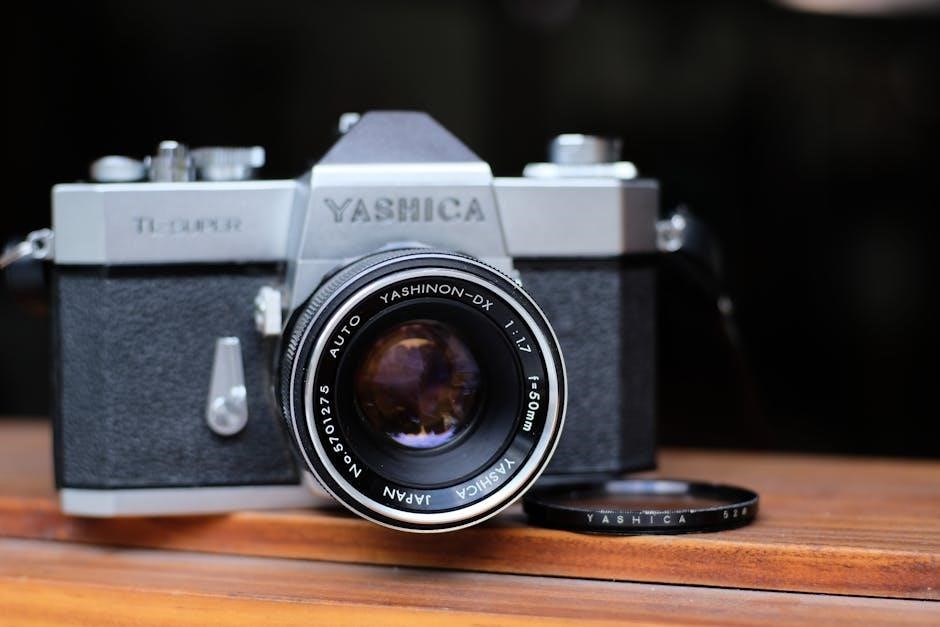
Key Features of the Yashica Mat 124
The Yashica Mat 124 features a twin-lens reflex design, compatibility with 120 and 220 film, aperture and shutter speed controls, and a built-in light meter for precise exposures.
Twin-Lens Reflex Design
The Yashica Mat 124 features a twin-lens reflex (TLR) design, with two lenses: one for viewing and composing shots, and another for capturing the image. This design allows for precise focusing and framing using the ground-glass screen, ensuring accurate composition. The TLR system eliminates viewfinder blackout during exposure, enabling continuous observation of the scene. The camera’s compact size and intuitive controls make it easy to handle, while the large viewfinder aids in achieving sharp focus. This design is particularly favored for medium-format photography, offering a balance between portability and image quality, making the Yashica Mat 124 a versatile tool for photographers seeking creative control and precision.
Compatibility with 120 and 220 Film
The Yashica Mat 124 is compatible with both 120 and 220 medium-format films. The 120 film provides 12 exposures per roll, while the 220 film offers 24 exposures, offering photographers flexibility based on their needs. This adaptability makes the camera versatile for various shooting scenarios. The camera’s design accommodates the different film types without requiring additional accessories, simplifying the process for users. Whether using 120 for higher quality or 220 for extended shooting sessions, the Mat 124 ensures seamless operation, allowing photographers to focus on creativity without technical hindrance, making it a reliable choice for both professional and amateur photographers alike in different settings and projects.
Aperture and Shutter Speed Controls
The Yashica Mat 124 features precise aperture and shutter speed controls, allowing photographers to achieve optimal exposures. The aperture ranges from f/3.5 to f/32, providing flexibility for depth of field adjustments. Shutter speeds range from 1 second to 1/500th of a second, offering control over motion and lighting. These controls work in tandem with the built-in light meter to ensure accurate exposures; The camera’s manual operation enables photographers to fine-tune settings for creative results. Understanding and mastering these controls is essential for harnessing the camera’s full potential, making it a powerful tool for both beginners and experienced photographers seeking precise control over their images.
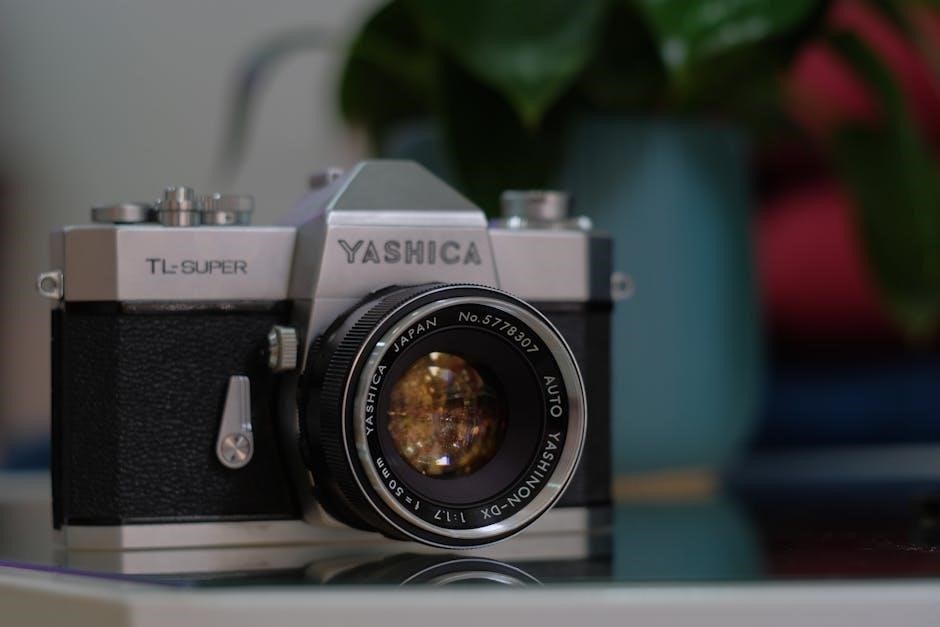
Camera Components and Controls
The Yashica Mat 124 features a twin-lens reflex design with a viewfinder, focusing screen, and controls for aperture, shutter speed, and flash synchronization. The film advance mechanism ensures precise frame alignment, while the built-in light meter aids in exposure settings.
Viewfinder and Focusing Screen
The Yashica Mat 124 features a bright and clear viewfinder that provides an accurate preview of the scene. The focusing screen is designed for precise manual focusing, with a central split-image prism for easy alignment. The viewfinder also includes frame lines to help compose shots. The focusing screen is interchangeable, allowing for customization based on personal preference or specific shooting needs. Proper use of the viewfinder and focusing screen ensures sharp images and precise control over composition. Regular cleaning and maintenance of these components are essential to maintain optical clarity and functionality. Always refer to the manual for detailed instructions on adjusting and caring for these critical parts.
Shutter Speed and Aperture Settings
The Yashica Mat 124 offers precise control over shutter speed and aperture settings, enabling photographers to achieve desired exposure levels. Shutter speeds range from 1/500th of a second to one second, with a bulb mode for extended exposures. The aperture control allows for adjustments from f/3.5 to f/32, providing flexibility in depth of field management. These settings are manually adjustable, requiring a thorough understanding of exposure principles for optimal results. The camera’s design ensures smooth operation of these controls, making it intuitive to dial in the perfect settings for various lighting conditions. Proper use of these features is essential for capturing high-quality images with the Mat 124.
Flash Synchronizer and Selector
The Yashica Mat 124 features a flash synchronizer and selector, enabling precise control over flash photography. The selector allows switching between different flash modes, ensuring compatibility with various flash units. When using F-class flashbulbs or electronic flash, the synchronizer must be set to ‘X’ for proper synchronization. This ensures accurate flash timing with the shutter mechanism. The guide number, typically found on the flash packaging, helps determine the correct aperture and distance settings for optimal exposure. Proper use of the flash synchronizer and selector enhances the camera’s versatility in low-light conditions, making it a valuable tool for photographers seeking professional-grade results with external lighting setups.

Film Handling and Loading
The Yashica Mat 124 accepts both 120 and 220 film formats, offering 12 and 24 exposures respectively. Loading is straightforward, with the camera featuring an efficient film advance mechanism that automatically counts exposures, ensuring precise control and ease of use for photographers.
Steps to Load 120 Film
- Ensure the camera is set to the 120 film mode using the film selector.
- Open the film compartment by releasing the latch on the right side.
- Remove the empty spool from the right side and insert the new 120 film spool.
- Gently pull the film leader and attach it to the empty take-up spool.
- Close the film compartment and advance the film using the advance lever until the next exposure appears in the red window.
- Set the exposure counter to 1 and ensure the film is properly seated.
- Your camera is now ready to shoot with 120 film.
Steps to Load 220 Film
- Set the film selector to the 220 film position to ensure proper compatibility.
- Open the film compartment by releasing the latch on the right side of the camera.
- Remove the empty spool from the right side and insert the new 220 film spool.
- Gently pull the film leader and attach it to the empty take-up spool, ensuring it aligns correctly.
- Close the film compartment and advance the film using the advance lever until the next exposure appears in the red window.
- Set the exposure counter to 1 and verify the film is properly seated.
- The camera is now ready to shoot with 220 film, providing 24 exposures.
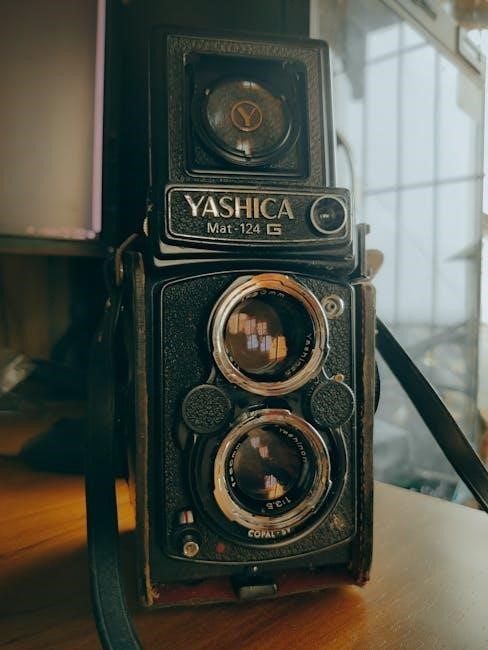
Film Advance and Exposure Counting
The Yashica Mat 124 features a manual film advance system. After loading the film, use the advance lever to move to the next frame. The red window on the back of the camera shows the exposure number. For 120 film, you get 12 exposures, while 220 film provides 24. Always advance the film after taking a shot to ensure the next frame is ready. The exposure counter on the top of the camera helps track your shots. Reset the counter when loading new film to maintain accurate counting. Proper film advance ensures sharp, evenly spaced images with no double exposures.

Shooting Modes and Techniques
The Yashica Mat 124 offers aperture priority and manual modes, providing photographers with creative control. Use the built-in light meter for precise exposures, ensuring optimal results in various lighting conditions.
Aperture Priority Mode
The Yashica Mat 124 features an Aperture Priority Mode, allowing photographers to set the desired aperture while the camera automatically adjusts the shutter speed. This mode is ideal for controlling depth of field, ensuring subjects stand out while backgrounds blur. Users can select apertures between f/3.5 and f/32, giving creative flexibility. The built-in light meter provides accurate exposure readings, enabling precise adjustments. This mode simplifies shooting, especially in changing lighting conditions, by letting the camera handle shutter speed calculations. It’s a convenient option for those prioritizing aperture control without the need for manual metering, making it a versatile choice for various photography scenarios.

Manual Mode for Full Control
Manual Mode on the Yashica Mat 124 offers full creative control, allowing photographers to set both aperture and shutter speed independently. This mode is ideal for experienced users who prefer precise adjustments to achieve desired effects. By adjusting the aperture ring and shutter speed dial, photographers can control depth of field and motion effects. The built-in light meter assists in determining accurate exposures, ensuring optimal results. Manual Mode is particularly useful in complex lighting conditions or when specific artistic effects are desired. It empowers users to take complete command of their photography, making it a powerful tool for mastering the craft of medium format film photography.
Using the Built-in Light Meter
The Yashica Mat 124 features a built-in light meter to help photographers achieve accurate exposures. To use it, align the match-needle system by adjusting the aperture and shutter speed until the needles overlap. This ensures proper exposure settings. The meter is highly sensitive and works effectively in various lighting conditions, providing reliable readings for both 120 and 220 film formats. By utilizing the light meter, photographers can maintain consistent image quality and avoid under or overexposure. This feature is particularly useful for beginners and professionals alike, offering a straightforward way to master exposure control without external tools.

Maintenance and Care
Regularly clean the lenses and viewfinder to ensure optimal performance. Lubricate moving parts periodically and store the camera in a dry, cool place to prevent damage.
Cleaning the Lenses and Viewfinder
Regular cleaning of the Yashica Mat 124’s lenses and viewfinder is essential for maintaining image clarity. Use a soft, dry microfiber cloth to gently wipe away dust and smudges. For stubborn marks, lightly dampen the cloth with distilled water, but avoid harsh chemicals. The viewfinder should be cleaned similarly, ensuring no moisture enters the camera. Inspect the lenses under bright light to spot imperfections. For deep cleaning, employ a lens cleaning tissue and a small amount of lens cleaning solution, applying it in circular motions. Avoid touching the glass surfaces to prevent oil residue. Clean the viewfinder’s glass and mirrors with extreme care to maintain accuracy. Regular maintenance ensures optimal performance and image quality. Always store the camera in a protective case when not in use to minimize dust exposure. Frequent checks and gentle cleaning will preserve your Yashica Mat 124 for years of reliable service. Avoid using tissues or cloths that may leave lint behind, as they can scratch the surfaces. For intricate areas, use a soft-bristled brush to remove loose debris before wiping. This meticulous approach ensures the camera’s optical components remain pristine, delivering sharp and clear photographs. By adhering to these cleaning practices, you will uphold the camera’s functionality and longevity, allowing it to continue capturing stunning images effortlessly. Remember, consistency is key to preventing dust and grime buildup; If unsure about any cleaning method, consult the official Yashica Mat 124 manual or seek advice from experienced photographers or professionals. Proper care will ensure your camera remains a trusted companion for all your photographic endeavors.
Lubrication of Moving Parts
Lubrication is crucial for the smooth operation of the Yashica Mat 124’s mechanical components. Apply a small amount of high-quality, lightweight grease to moving parts like the film advance mechanism, aperture rings, and shutter blades. Avoid over-lubrication, as excess grease can attract dust and impede functionality. Use a clean, dry cloth to wipe away any surplus. Lubricate the gears and hinges sparingly, ensuring the camera’s precision engineering remains unimpaired. Regular lubrication prevents wear and tear, maintaining the camera’s performance and longevity. Always refer to the official manual for specific guidance on lubricating sensitive areas without damaging electrical components or light meters. Proper lubrication ensures seamless operation and extends the camera’s lifespan, allowing it to function effectively for years. Regular checks and timely lubrication are essential for preserving the Yashica Mat 124’s mechanical integrity. If unsure, consult a professional or the official repair manual to avoid causing irreversible damage. By keeping the moving parts well-lubricated, you ensure the camera remains a reliable tool for capturing exceptional photographs. This maintenance step is vital for sustaining the camera’s optimal performance and ensuring it continues to deliver outstanding results. remember, consistency in lubrication is key to preventing mechanical failure and maintaining the camera’s precision engineering. Always prioritize gentle and precise application to protect your Yashica Mat 124.
DIY Repair and Maintenance Tips
For the Yashica Mat 124, DIY repairs can save costs and extend its lifespan. Start by consulting the official repair manual or online guides for detailed instructions. Clean the lenses and viewfinder regularly using soft cloths and mild solvents to prevent dust buildup. Adjust the shutter speeds and aperture settings carefully, ensuring accuracy. Lubricate moving parts sparingly with high-quality grease to maintain smooth operation. Replace worn seals or hinges to prevent light leaks and mechanical failures. Use screwdrivers to tighten loose components, but avoid over-tightening. Refer to online forums or community groups for troubleshooting tips and shared experiences. Always handle the camera with care to avoid damaging its intricate mechanisms. Regular DIY maintenance ensures the Yashica Mat 124 remains functional and continues to deliver exceptional photography results.
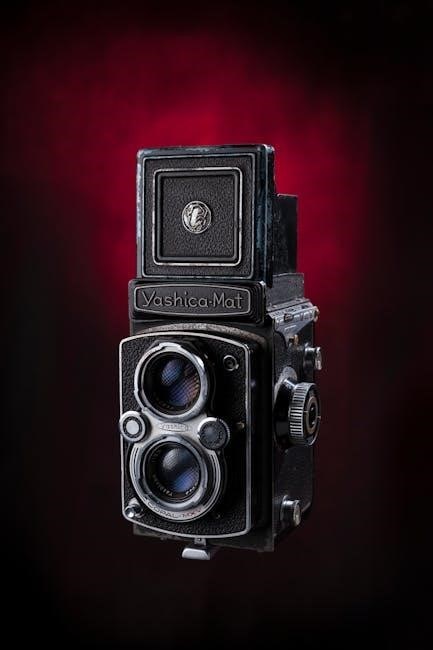
Troubleshooting Common Issues
Address shutter malfunctions by cleaning or replacing faulty components. Check film advance issues by ensuring proper loading and alignment. Regularly clean lenses and viewfinder for optimal performance. Adjust settings carefully to avoid mechanical stress. Refer to the manual or online guides for detailed solutions to specific problems. Prevent issues with routine maintenance and proper handling.
Shutter Malfunction Solutions
Experiencing shutter malfunctions with your Yashica Mat 124? Start by cleaning the shutter curtains with a soft brush to remove dirt or debris. If issues persist, inspect the shutter mechanism for wear or damage. Lubricate moving parts with a silicone-based lubricant to ensure smooth operation. Adjust the shutter speed settings to ensure proper synchronization. For complex repairs, consult the official repair manual or seek guidance from online forums and communities. Regular maintenance and careful handling can prevent future malfunctions, ensuring your camera continues to function optimally.
Film Advance Mechanism Problems
If the film advance mechanism on your Yashica Mat 124 is jammed or not functioning properly, check for obstructions such as loose film or debris. Ensure the film is loaded correctly and the pressure plate is aligned. If the issue persists, gently clean the mechanism with a soft brush to remove dust or dirt. Lubricate the moving parts if necessary, but avoid over-lubrication. For severe problems, refer to the repair manual or seek professional assistance. Proper maintenance and regular inspection can help prevent such issues, ensuring smooth film advancement and accurate exposure counting.
Common Error Prevention Tips
To prevent errors when using the Yashica Mat 124, ensure proper film loading by aligning the film with the pressure plate and advancing it correctly. Regularly clean the lenses and viewfinder to avoid smudges or debris affecting your shots. Always check the shutter speed and aperture settings before taking a photo. Store the camera in a cool, dry place to prevent mechanical wear and tear. Avoid over-lubricating moving parts, as this can attract dust and cause malfunctions. By following these tips, you can minimize common issues and ensure optimal performance of your Yashica Mat 124 camera.
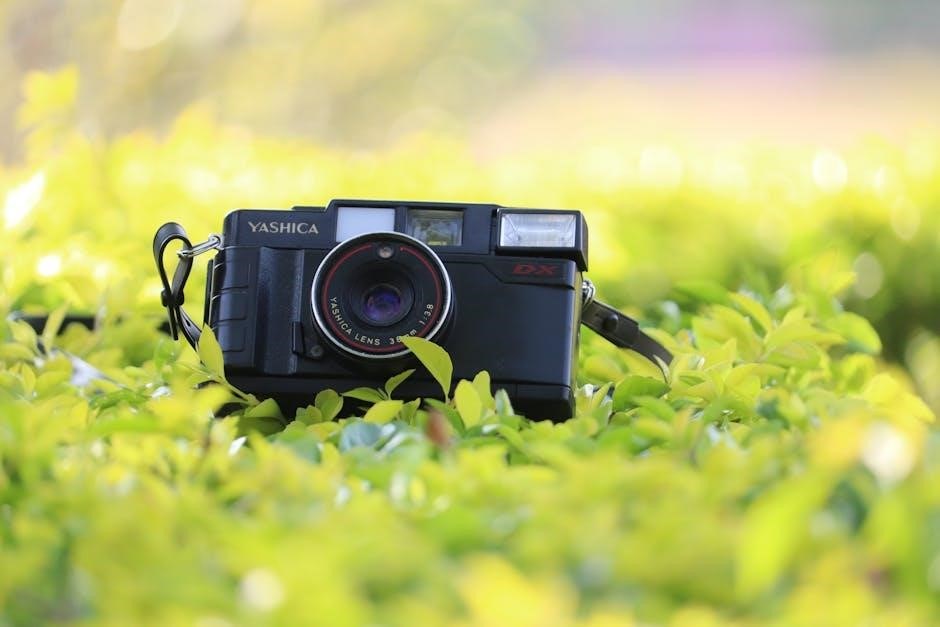
Resources and References
Find official Yashica Mat 124 manuals, repair guides, and tutorials online. Community forums and support groups offer valuable insights and troubleshooting tips for optimal camera usage and maintenance.
Official Yashica Mat 124 Manual
The official Yashica Mat 124 manual provides comprehensive guidance for operating and maintaining the camera. Available in PDF format, it details camera components, controls, and setup procedures. The manual covers film loading for both 120 and 220 formats, aperture and shutter settings, and flash synchronization. It also includes troubleshooting tips for common issues like shutter malfunctions and film advance problems. Originally written in English, translated versions, such as the Italian manual, are also available. This essential resource ensures users can fully utilize the camera’s features and resolve issues effectively. It remains a vital tool for both novice and experienced photographers using the Yashica Mat 124.
Online Repair Guides and Tutorials
Online repair guides and tutorials for the Yashica Mat 124 are readily available, offering step-by-step instructions for DIY maintenance and fixes. Platforms like Scribd and dedicated camera forums host PDF manuals and repair documents, such as the “Yashica Mat 124G Repair Manual.” These resources cover common issues like shutter malfunctions, film advance problems, and lens cleaning. Tutorials often include detailed photos and diagrams, making complex repairs more accessible. Many guides are free to download or view online, providing photographers with the tools to keep their Yashica Mat 124 in optimal condition. These resources are invaluable for enthusiasts aiming to extend the camera’s lifespan and functionality.
Community Forums and Support Groups
Community forums and support groups dedicated to the Yashica Mat 124 provide invaluable resources for photographers. Platforms like Flickr, Facebook groups, and specialized photography forums host discussions, troubleshooting tips, and user experiences. These communities are excellent for connecting with other Yashica Mat 124 users, sharing techniques, and solving common issues; Many groups also feature galleries showcasing photos taken with the camera, offering inspiration and insight into its capabilities. Additionally, these forums often include threads on maintenance, repair, and modifications, making them a go-to destination for both novice and experienced photographers seeking advice or camaraderie. The collective knowledge within these communities is a powerful tool for optimizing your Yashica Mat 124 experience.